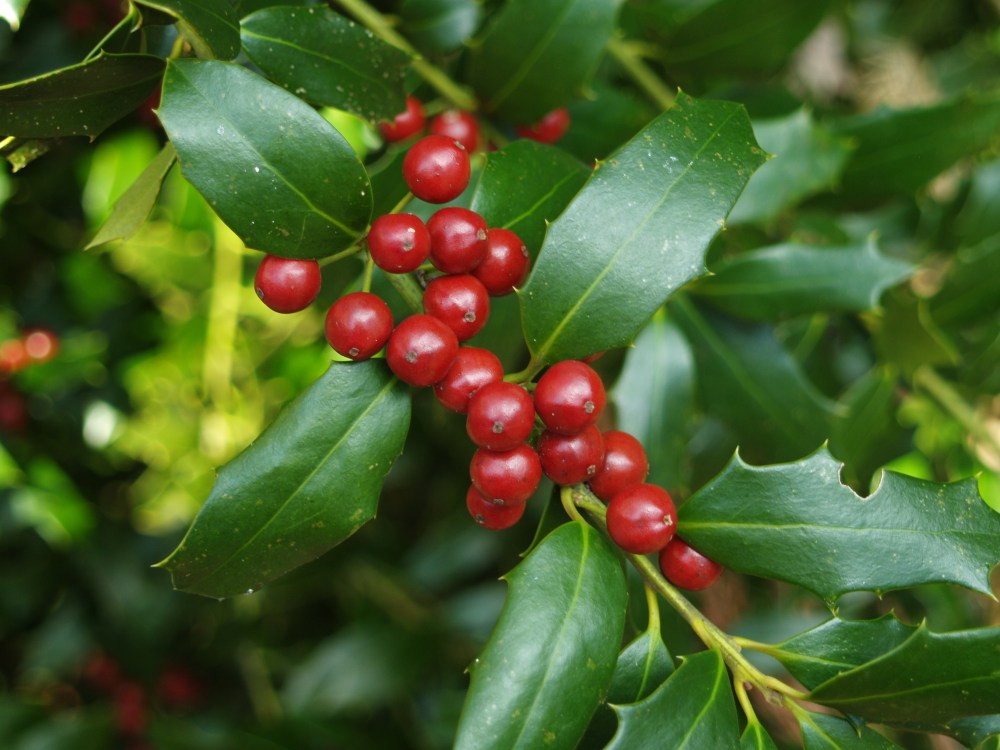The variegated English hollies (Ilex aquifolium ‘Argenteo marginata’, below) have no berries. I suppose that all four are males, or perhaps there is not a male pollinator for the females. I’m not observant enough to detect the sex of the hollies from the flowers, so I’ll enjoy the variegated foliage and if they should ever get berries that will be a bonus. Berries or not, these are wonderful hollies.
English hollies are only marginally cold hardy in my northwestern Virginia garden, but with our winters ever warmer they have never had trouble surviving the winter months. They grow slowly in comparison to other hollies in the garden, possibly because there is some unseen injury from cold, but it’s more likely they suffer in the summer’s heat and humidity. 
The foliage of the Koehne holly (Ilex x koehneana, above) is similar to the green leafed English holly, but it is more cold hardy and it grows vigorously in my garden. Vigorously enough, unfortunately, that my wife reminds me regularly that it should not have been planted so close to the driveway. I promise, it’s not a problem, but she’s not easily convinced.
The Koehne holly is not commonly found in garden centers, but it merits greater attention, to my thinking. Its broad, dark foliage provides an ideal background to the abundant red berries. It grows wider in relation to its height than other hollies in the garden, and here is the problem with the driveway, which I’ve assured you is not a problem at all.
Dragon Lady (Ilex x aquipernyi ‘Meschick’ or ‘Dragon Lady’) and Centennial Girl hollies (Ilex centrochinensis x aquifolium ‘Centennial Girl’, above) have similarly dark foliage, and both are hybrids of the English holly. Both berry heavily in late autumn, though two ‘Dragon Lady’ hollies in my garden are shaded enough that they have no berries at all in recent years.
The leaves of ‘Dragon Lady’ are sharply spined enough to cause injury in handling, but the spines on ‘Centennial Girl’ are more pliable and relatively harmless. Both are more narrow in form than other large, pyramidal hollies, and this allows planting closer to houses, decks, walkways, and such, though a twenty feet tall holly will still require a space of six or eight feet. These are excellent hollies, and more cold hardy than other hollies in the garden.
Golden Girl holly (Ilex x meserveae Golden Girl’, above) has similar foliage to ‘Dragon Lady’ and ‘Centennial Girl’, with spines that will snag, but not injure. As the name implies, berries are not red, but yellow. ‘Golden Girl’ is one of the group of hollies designated as Blue hollies, all with dark blue-green foliage. I’ve found that blue hollies are not especially tolerant of poorly drained clay soil, but I’ve planted two ‘Golden Girl’ hollies in a partially shaded spot with better than average soil and a thick cover of leaf litter, so I expect they will do well. I suppose that red berries are preferable, but in a garden with many thousands of red berries the yellows are welcomed. 
In mid December, the branches of Christmas Jewel holly (Ilex x ‘Christmas Jewel’, above) are lined with red berries. It has perhaps the most abundant berries of hollies in the garden, though one is planted in the shade of a tall cryptomeria and the other in nearly full sun. ‘Christmas Jewel’ is the shortest growing of the large hollies, only to ten feet or so, and nearly as wide, but with a wide pyramidal form. It is relatively uncommon in garden centers, but is easily recognizable when branches are cloaked in red.
